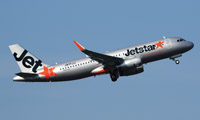News Backgrounder
Good but not good enough
JAL chairman tells Tom Ballantyne.
July 1st 2014
Japan Airlines’ chairman has his fiscal ducks in a row as the airline tracks towards full recovery after its humiliating period of bankruptcy protection in 2010. Read More »
Top of Masaru Onishi’s bucket list for JAL is an “A” grade financial rating for the current fiscal year, despite the airline’s 3.2% dip in its recovery trajectory, to US$1.6 billion, for the latest 12 months. Onishi told Orient Aviation last month that this financial year would also produce lower profits, a forecast $1.1 billion profit, due mainly to over-capacity issues.
“Once we have achieved this “A” grade financial target, we will specifically look at what our dividends need to be to pay back our investors,’ he said at a recent oneworld briefing.
 |
| 'You have a 150-seat plane and LCCs will try to fly it as a 180-seat plane, which cuts the cost per passenger. Japanese LCCs face certain regulatory issues, but we believe the business model will succeed' |
| Masuru Onishi Japan Airlines chairman |
“We have achieved a certain level of profitability, but if you look at our balance sheet you will see there are many issues we must address to improve ourselves financially.”
The 3.2% decline in JAL’s net profit was attributed to fuel costs increasing to $2.8 billion, or 25% of total operating costs, and a 25% reduction in the value of the yen against the US dollar.
“It could be said today that JAL is comparably healthy financially. But we believe the aviation industry continues to be very volatile. There needs to be a lot more done to maintain the financial health that JAL is in right now,” said Onishi.
In the meantime, Onishi said JAL “continues to explain to our shareholders what we are doing to improve the company. It is a matter of building up our financial strength”.
One reason for Onishi;s caution is that JAL is facing “intensifying competition” at Tokyo metropolitan airports as a result of the dramatic increase in flight slots at Haneda airport. Nearly 80 flights arrive and depart from Tokyo Haneda every hour, a 50% jump from a year earlier, explained Onishi.
The expansion followed the allocation of additional domestic slots at Haneda last year, most of which went to JAL rival, All Nippon Airways (ANA). “The result is an imbalance in the supply and demand at the airport.
“It is not so much that ANA received more slots than JAL,” said Onishi. “It is the fact that there has been a large increase in the supply at Haneda and demand has not matched the expansion. “The pattern was repeated this fiscal year for international flights. We have increased slots and the demand has not kept up. Based on this situation, we forecast business will be a little difficult for us in this year.”
But it will be a short-term problem, predicted the JAL chairman. “In the next eighteen months, with the increase in capacity we have planned, demand will catch up,” he said.
“Our current fleet plan is included in our mid-term business plan to fiscal year 2016, so we do not feel we need to review any fleet issues now.”
JAL has essentially finalized its medium to long-term wide-body fleet acquisition plan. Last October, it broke with tradition and ordered 18 A350-900s and 13 A350-1000s, with options on another 25 aircraft. Deliveries are to start in 2019.
 |
| Jetstar joint venture will succeed, JAL chairman Onishi said |
It was the first wide-body commitment for Airbus from either JAL or ANA. Japanese carriers had always been Boeing customers. “In making our decision between the B777 and A350, we did a lot of homework,” said Onishi.
“A lot of minute details were studied. We came to the conclusion that for our business model the A350 was a little more advantageous to JAL. Hence we intend to look at the A350 as a replacement for our older 777s,” explained Onishi.
The JAL fleet of B737-800s still had a working life so any plans for replacement in that area were on hold. “What we need to do is not only look for a smaller regional jets, but also have our share of propeller aircraft to serve smaller regional markets. We need to start looking into them in the very near future.”
Onishi is more than confident about one aspect of the business, the future of its joint venture with Qantas, low-cost carrier (LCC) Jetstar Japan. “LCCs in Japan are a viable business model and destined for success, predicted Onishi.
“Their primary objective is to expand quickly and grab market share. However, because Japan has regulatory restrictions that are still very conservative, it can make it difficult for LCCs to grow.”
Jetstar Japan had a rocky beginning, mainly related to operational difficulties, which required JAL and Qantas Group to invest an additional $113.6 million into the budget carrier.
“JAL’s job now is to support Jetstar Japan and provide them with an environment that facilitates expansion in the market. The core of the business plan for LCCs is to expand and at the same time try to lower costs, especially overhead costs,” he said.
“You have a 150-seat plane. They will try to fly this as a 180-seat plane, which brings down the cost per passenger. Down the line we believe the business model will succeed.”
While two of Japan’s LCCs, Vanilla and Peach, are facing problems because of pilot shortages and recently announced major cancellations of flights, Onishi said it was not an issue at JAL.
“When we went into bankruptcy protection in 2010 we were forced to change the roles of some of our pilots, from the flight deck to working on the ground. Since then, our total business has expanded slightly and we have decided to bring these pilots back. We are retraining them, which means we will not face any pilot shortage whatsoever,” Onishi said.